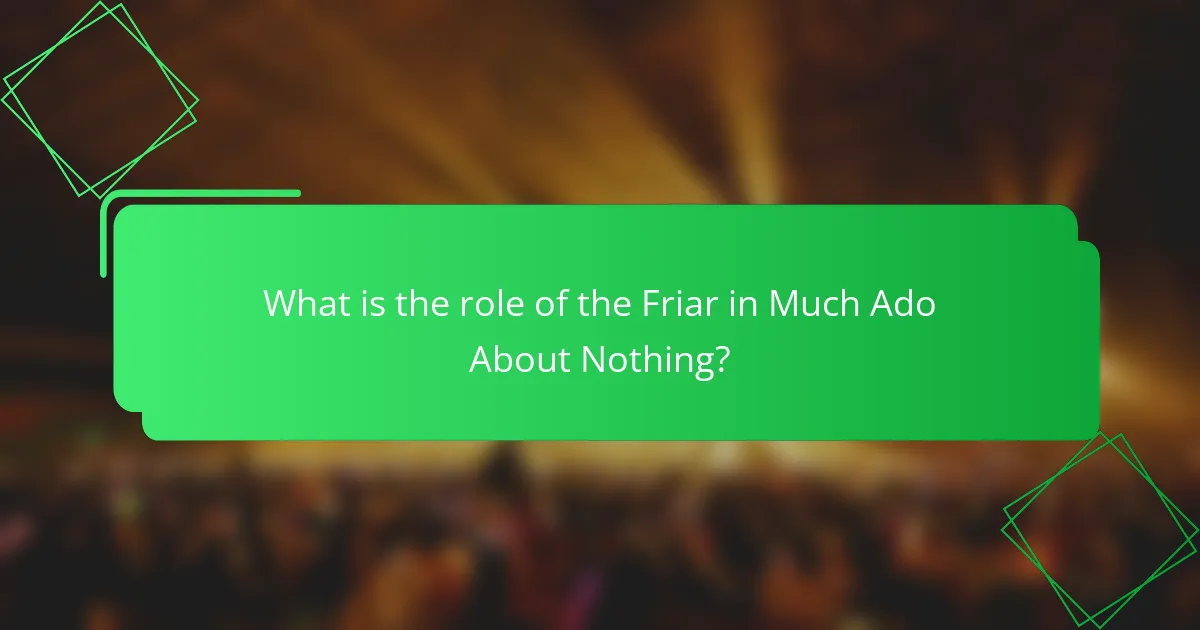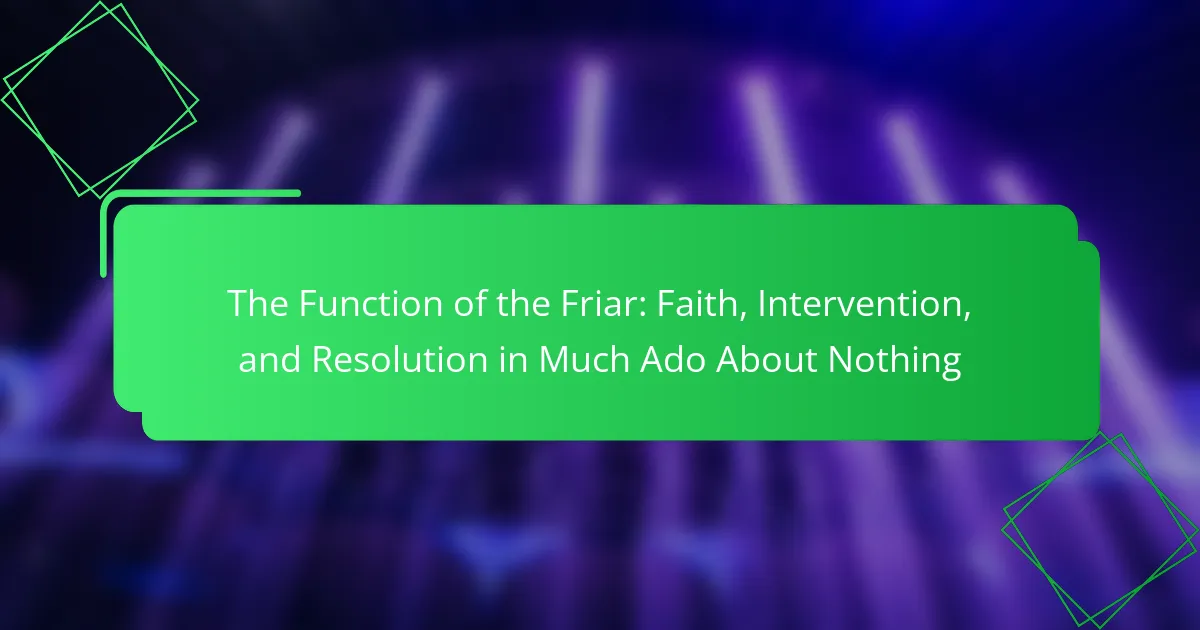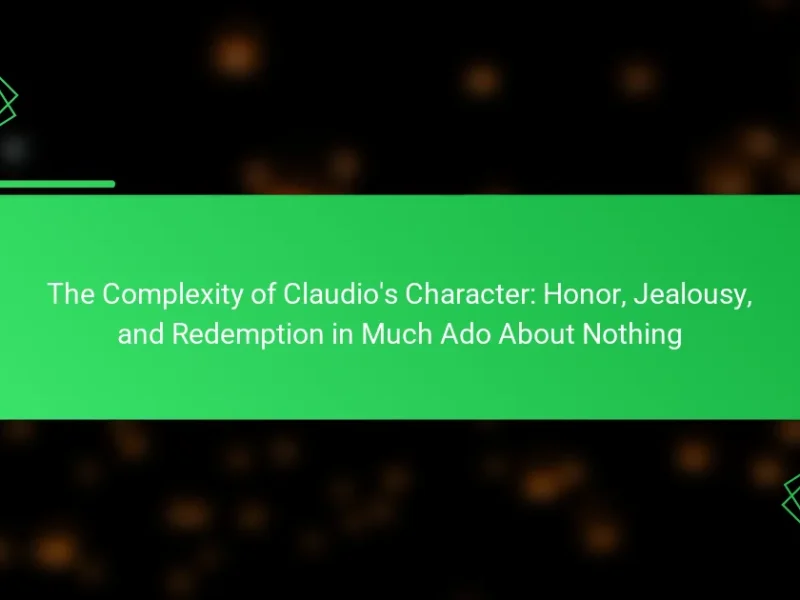
What is the role of the Friar in Much Ado About Nothing?
The Friar in Much Ado About Nothing serves as a mediator and advisor. He plays a crucial role in resolving conflicts among characters. The Friar helps to orchestrate the plan to fake Hero’s death. This deception aims to expose Claudio’s wrongful accusations. His actions reflect themes of faith and redemption. The Friar also provides counsel to characters seeking guidance. His presence emphasizes the importance of forgiveness and reconciliation. Ultimately, the Friar’s interventions lead to a resolution of misunderstandings.
How does the Friar’s faith influence his actions?
The Friar’s faith significantly influences his actions throughout “Much Ado About Nothing.” His belief in redemption shapes his approach to conflicts. He often seeks to mediate disputes rather than escalate them. The Friar believes in the power of love and forgiveness. This leads him to devise plans to resolve misunderstandings. For instance, he creates the scheme to fake Hero’s death. This act is intended to restore honor and reunite the lovers. His faith drives him to act as a peacemaker in the community. Ultimately, the Friar’s faith guides his interventions and resolutions in the play.
What are the key beliefs that guide the Friar’s decisions?
The key beliefs that guide the Friar’s decisions include a strong commitment to faith, mercy, and reconciliation. The Friar believes in the power of love and forgiveness to heal relationships. He intervenes in conflicts, aiming to restore harmony among characters. His faith influences his actions, leading him to trust in divine intervention. The Friar also prioritizes moral integrity and seeks to guide others toward righteousness. He views himself as a mediator, promoting understanding and resolution. These beliefs shape his role in the narrative, as he attempts to navigate complex social dynamics. His actions reflect a deep understanding of human nature and the need for compassion.
How does the Friar’s faith impact the other characters?
The Friar’s faith significantly impacts other characters by providing guidance and resolution. His belief in the power of redemption influences Claudio’s perspective on honor and love. The Friar’s intervention helps to reconcile misunderstandings between characters. For instance, he devises a plan to fake Hero’s death to restore her honor. This strategy directly affects Claudio, who is led to regret his actions. The Friar’s faith also instills hope in Hero and Beatrice. His presence encourages them to trust in the possibility of reconciliation. Ultimately, the Friar’s faith serves as a catalyst for healing and forgiveness among the characters.
What interventions does the Friar make throughout the play?
The Friar intervenes multiple times throughout “Much Ado About Nothing.” He first proposes a plan to fake Hero’s death to protect her honor. This intervention aims to give Claudio a chance to redeem himself. The Friar also helps to orchestrate the reconciliation between Beatrice and Benedick. His actions demonstrate his role as a mediator and problem-solver. Additionally, he provides counsel to the characters, emphasizing themes of love and forgiveness. The Friar’s interventions ultimately drive the plot toward resolution and harmony.
What specific situations require the Friar’s intervention?
The Friar’s intervention is required in situations of conflict and misunderstanding. Notably, he intervenes when Claudio publicly shames Hero at their wedding. The Friar seeks to resolve the situation by devising a plan to feign Hero’s death. This intervention aims to restore Hero’s honor and rectify Claudio’s wrongdoing. Additionally, the Friar addresses the confusion surrounding the mistaken identity of the characters. His role emphasizes the importance of reconciliation and forgiveness in the narrative. These interventions highlight the Friar’s function as a mediator and a source of wisdom.
How effective are the Friar’s interventions in resolving conflicts?
The Friar’s interventions are moderately effective in resolving conflicts. He attempts to mediate between characters such as Claudio and Hero. His strategy includes devising plans to address misunderstandings. For instance, he suggests a fake death for Hero to expose Claudio’s true feelings. This intervention ultimately leads to reconciliation. However, his plans are not foolproof and result in additional complications. The effectiveness of his interventions is limited by the characters’ actions and misunderstandings. Overall, the Friar plays a crucial role but cannot control the outcomes fully.
What resolutions does the Friar help to achieve?
The Friar helps to achieve resolutions of misunderstandings and conflicts among characters. He plays a crucial role in restoring harmony in relationships. For example, he devises a plan to fake Hero’s death to resolve her dishonor. This intervention leads to the eventual reconciliation between Hero and Claudio. The Friar also promotes forgiveness and redemption throughout the narrative. His wisdom guides characters towards self-reflection and resolution of their issues. The outcomes of his actions emphasize the themes of love and trust. Thus, the Friar’s role is pivotal in achieving resolution in “Much Ado About Nothing.”
How does the Friar contribute to the play’s ultimate resolution?
The Friar contributes to the play’s ultimate resolution by facilitating the reconciliation of key characters. He devises a plan to fake Hero’s death, which prompts Claudio’s remorse. This intervention ultimately leads to the truth being revealed. The Friar’s actions create a turning point in the narrative. His role emphasizes themes of faith and redemption. By orchestrating the events, he helps restore harmony among the characters. The resolution hinges on his strategic thinking and compassionate nature. Thus, the Friar is essential for resolving the conflict and uniting the couples.
What lessons about resolution can be learned from the Friar’s actions?
The Friar’s actions demonstrate the importance of proactive intervention in resolving conflicts. He takes initiative to mediate between characters, showing that communication can lead to understanding. The Friar’s strategic planning reveals that thoughtful resolution requires foresight and consideration of all parties involved. His willingness to offer solutions underscores the value of empathy in conflict resolution. By devising a plan to fake Hero’s death, he illustrates that unconventional methods can sometimes facilitate reconciliation. The Friar’s role emphasizes that resolution often requires courage to confront difficult situations. Ultimately, his actions teach that resolution is a collaborative effort that benefits from guidance and support.
How does the Friar’s character reflect broader themes in the play?
The Friar’s character reflects broader themes of faith and intervention in “Much Ado About Nothing.” He embodies the theme of misguided intentions through his well-meaning but ultimately flawed plans. The Friar’s attempt to resolve issues through deception highlights the consequences of miscommunication. His role emphasizes the importance of trust and the fragility of relationships. The Friar’s faith in love and redemption showcases the play’s exploration of forgiveness. His involvement in the plot to fake Hero’s death illustrates the theme of societal expectations. The character serves as a catalyst for resolution, driving the narrative towards reconciliation. Overall, the Friar’s actions underscore the complex interplay of faith, love, and the consequences of intervention.
In what ways does the Friar symbolize faith and reason?
The Friar symbolizes faith through his spiritual authority and role as a mediator. He embodies religious belief by advocating for forgiveness and reconciliation among characters. The Friar also symbolizes reason by using logic to navigate conflicts and offer solutions. He analyzes situations carefully before acting, demonstrating a rational approach to problem-solving. For instance, he devises a plan to fake Hero’s death to resolve her wrongful accusation. This blend of faith and reason highlights his importance in guiding characters toward resolution. The Friar’s actions reflect a balance between spiritual guidance and practical wisdom, reinforcing the themes of faith and reason within the narrative.
How does the Friar’s role relate to the theme of deception?
The Friar’s role in “Much Ado About Nothing” is closely tied to the theme of deception. He orchestrates a plan that involves feigning death to expose true feelings and motivations. This deception ultimately leads to the revelation of Claudio’s misguided judgments about Hero. The Friar’s actions demonstrate how deception can serve as a tool for resolution and truth. His strategic manipulation of events highlights the complexities of human relationships and the necessity of misunderstanding for character growth. The resolution of the plot hinges on the successful execution of his deceptive plan, showcasing the dual nature of deception as both harmful and beneficial.
What can we learn from the Friar’s approach to conflict resolution?
The Friar’s approach to conflict resolution emphasizes the importance of understanding and compassion. He advocates for dialogue over violence. The Friar seeks to mediate disputes rather than escalate them. His methods involve careful listening and consideration of all perspectives. He demonstrates that patience can lead to reconciliation. The Friar’s strategies highlight the value of forgiveness in resolving conflicts. His actions show that intervention can prevent tragedy. Overall, the Friar teaches that empathy and communication are key to resolving disputes effectively.
What strategies does the Friar use that can be applied in real life?
The Friar uses strategies of mediation, fostering forgiveness, and promoting honest communication that can be applied in real life. He mediates conflicts between characters to restore harmony, demonstrating the importance of dialogue in resolving disputes. The Friar encourages forgiveness, illustrating how letting go of grudges can lead to healing. He also emphasizes the value of truthfulness, as seen when he devises a plan based on honesty to address misunderstandings. These strategies highlight the significance of empathy, reconciliation, and open communication in everyday life.
How can the Friar’s methods inform modern perspectives on mediation?
The Friar’s methods can inform modern perspectives on mediation by emphasizing the importance of neutrality and empathy. He approaches conflicts with a calm demeanor, allowing all parties to express their views. His strategy includes active listening, which fosters understanding among conflicting individuals. Furthermore, the Friar employs creative problem-solving techniques to address disputes. He suggests alternative solutions that consider the needs of all involved. This approach aligns with contemporary mediation practices that prioritize collaboration over confrontation. Historical examples demonstrate that effective mediators, like the Friar, create environments conducive to resolution. His methods encourage open dialogue, essential for successful mediation today.
The main entity of the article is the Friar in “Much Ado About Nothing.” The article explores the Friar’s role as a mediator and advisor, highlighting his influence on conflict resolution through faith and strategic interventions. Key themes include the importance of forgiveness, love, and redemption, as well as the Friar’s impact on other characters’ perspectives and relationships. The article also examines the effectiveness of the Friar’s interventions, the lessons learned from his approach to conflict resolution, and how his methods can inform modern mediation practices.


